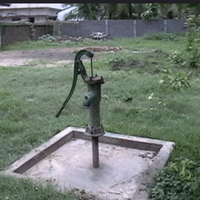
Sarthak Gaurav
I am an economist with core research interest in the areas of risk and insurance, agricultural economics, behavioural economics, longitudinal village level studies, and health economics. I have been teaching and researching at Shailesh J.Mehta School of Management at IIT Bombay since fall 2015. I teach Microeconomics, Macroeconomics, Game Theory, and Behavioural Economics to post-graduate and doctoral students at IIT Bombay. My field work is in Vidarbha region of Maharashtra, rural Gujarat, Bihar, Uttar Pradesh, and Odisha.
Supervisors: Dr.Srijit Mishra, Dr.Shawn Cole, and Dr.Sripad Motiram
Supervisors: Dr.Srijit Mishra, Dr.Shawn Cole, and Dr.Sripad Motiram
less
Related Authors
Noel B. Salazar
KU Leuven
Mustafa Ozbilgin
Brunel University
Patricia Rogers
RMIT University
Don Ross
University College Cork
Johnna Montgomerie
Goldsmiths, University of London
Radhika Gajjala
Bowling Green State University
David Seamon
Kansas State University
Jill Trepanier
Louisiana State University
Anoop Chaturvedi
University of Allahabad
Adam M Croom
Case Western Reserve University
InterestsView All (18)










Uploads
Papers by Sarthak Gaurav
deplorable. A typical chowkidar is a middle-aged male with poor
education and skills, working in urban areas on a low salary and without any written job contract or social security coverage. Instead of appropriating them as a metaphor for political gains,ensuring their job security should be a policy priority.
Design/methodology/approach – The study discusses frameworks for evaluation of the impact of direct benefit transfers such as KALIA. It uses the Agriculture Census 2015-16 to understand the patterns of operational holding in the state. In order to generate an estimate of the cultivation income relevant for a baseline of KALIA, and examine the scope of livelihood augmentation programmes, it uses unit level data from the NSS 70th Round Situation Assessment Survey of Agricultural Households, 2012-13.
Findings – Findings suggest that the preponderant small and marginal farmers in the state of Odisha receive abysmally low returns from cultivation. Financial assistance under KALIA though justifiable as a temporary relief may not suffice to create sustainable livelihood impacts unless structural problems in agricultural markets are fixed, and greater non-farm diversification opportunities are created in the state.
Originality/value – Despite the general state of agrarian crisis in the country and concerns about low agricultural incomes in the state of Odisha, there is no baseline for understanding how livelihood augmentation programmes such as KALIA could impact welfare of agricultural households. This study uses unit level data from NSSO and Agriculture Census data to construct such a baseline. In doing so, it highlights the low net returns to cultivation across size-class of land possessed and identifies potential policy implications. It also emphasizes the need for rigorous evaluation of impacts of public programmes such as KALIA.
banking philosophy based on mutuality, there is scant
evidence on efficiency of cooperative banks. The
efficiency of district central cooperative banks in India is
investigated by constructing a panel of 297 cooperative
banks over the period 2002–14. Using parametric and
non-parametric frontier analysis, it is found that
efficiency estimates vary depending upon whether
advances or investments of DCCBs are used as output.
The efficiency of cooperative banking is mapped, and
shows considerable variation in efficiency of DCCBs across
states. The findings suggest the need for innovative
strategies to improve cooperative banking efficiency
in the country.
differently when gambles are framed as yield risk or price risk, we present these income
distributions as those with constant price and variable yield to a set of farmers and those with constant yield and variable price to another set of farmers. We find that a significant number
of farmers violate stochastic dominance, an assumption central to the validity of rational decision making. We also inquire whether such behaviour is related to their self-reported risk attitudes. We find that farmers who perceive themselves as risk takers are more likely to
violate stochastic dominance than those who perceive themselves as risk avoiders. We explore reasons for such behaviour and posit conditions under which configural weight theories of decision making could explain such behaviour.
of firms to save cash out of cash flows. Drawing on cash-cash flow sensitivity (CCFS), we
overcome the errors in attributing information in cash flows to real and financial components.
We employ endogenous regime switching model for our empirical exercise. This model
allows for multiple sorting variables, does not require finance constraints to increase
monotonically with the sorting variables and enables firms to endogenously change regime
over the sample period. Our findings suggest that firms portray significantly higher CCFS in
the event of finance constraints.
deplorable. A typical chowkidar is a middle-aged male with poor
education and skills, working in urban areas on a low salary and without any written job contract or social security coverage. Instead of appropriating them as a metaphor for political gains,ensuring their job security should be a policy priority.
Design/methodology/approach – The study discusses frameworks for evaluation of the impact of direct benefit transfers such as KALIA. It uses the Agriculture Census 2015-16 to understand the patterns of operational holding in the state. In order to generate an estimate of the cultivation income relevant for a baseline of KALIA, and examine the scope of livelihood augmentation programmes, it uses unit level data from the NSS 70th Round Situation Assessment Survey of Agricultural Households, 2012-13.
Findings – Findings suggest that the preponderant small and marginal farmers in the state of Odisha receive abysmally low returns from cultivation. Financial assistance under KALIA though justifiable as a temporary relief may not suffice to create sustainable livelihood impacts unless structural problems in agricultural markets are fixed, and greater non-farm diversification opportunities are created in the state.
Originality/value – Despite the general state of agrarian crisis in the country and concerns about low agricultural incomes in the state of Odisha, there is no baseline for understanding how livelihood augmentation programmes such as KALIA could impact welfare of agricultural households. This study uses unit level data from NSSO and Agriculture Census data to construct such a baseline. In doing so, it highlights the low net returns to cultivation across size-class of land possessed and identifies potential policy implications. It also emphasizes the need for rigorous evaluation of impacts of public programmes such as KALIA.
banking philosophy based on mutuality, there is scant
evidence on efficiency of cooperative banks. The
efficiency of district central cooperative banks in India is
investigated by constructing a panel of 297 cooperative
banks over the period 2002–14. Using parametric and
non-parametric frontier analysis, it is found that
efficiency estimates vary depending upon whether
advances or investments of DCCBs are used as output.
The efficiency of cooperative banking is mapped, and
shows considerable variation in efficiency of DCCBs across
states. The findings suggest the need for innovative
strategies to improve cooperative banking efficiency
in the country.
differently when gambles are framed as yield risk or price risk, we present these income
distributions as those with constant price and variable yield to a set of farmers and those with constant yield and variable price to another set of farmers. We find that a significant number
of farmers violate stochastic dominance, an assumption central to the validity of rational decision making. We also inquire whether such behaviour is related to their self-reported risk attitudes. We find that farmers who perceive themselves as risk takers are more likely to
violate stochastic dominance than those who perceive themselves as risk avoiders. We explore reasons for such behaviour and posit conditions under which configural weight theories of decision making could explain such behaviour.
of firms to save cash out of cash flows. Drawing on cash-cash flow sensitivity (CCFS), we
overcome the errors in attributing information in cash flows to real and financial components.
We employ endogenous regime switching model for our empirical exercise. This model
allows for multiple sorting variables, does not require finance constraints to increase
monotonically with the sorting variables and enables firms to endogenously change regime
over the sample period. Our findings suggest that firms portray significantly higher CCFS in
the event of finance constraints.